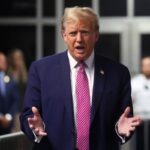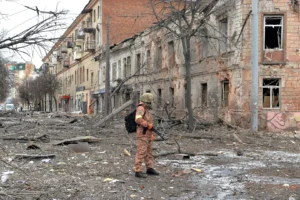Electric cars are rolling off production lines, and one in five new cars sold in California this year is battery-powered. “California is showing the world what’s possible,” said Gov. Gavin Newsom, whose plan to phase out fossil fuels and gasoline-powered cars is key to his ambitions of tackling climate change.
But as California steers away from the internal combustion engine, the rapid transition is fueling a fight in the Capitol over how large a role hydrogen fuel cells will play in powering the clean cars of the future.
Democrats in the state Legislature are debating how much money to give companies to build hydrogen fueling stations. A lobbying group for hydrogen supporters and suppliers, including Chevron, Shell and Toyota, is seeking a designated 30% share of money from the state Clean Transportation Program, amounting to $300 million over the next decade.
The program is funded by annual fees paid by California drivers — $2 car registration fees and $4 smog abatement fees. Over the last decade, hydrogen has been earmarked for 20% of its funds.
So far, the California Energy Commission has spent $202 million for hydrogen fueling stations. Yet there is still low demand for the cars, with sluggish sales: Only two hydrogen models are available, the Toyota Mirai and Hyundai Nexo, and only 1,767 have been sold in California this year. Last year’s sales declined 20% although sales are up this summer.
In all, Californians own only about 12,000 hydrogen-powered cars, compared to more than 760,000 powered by batteries.
Like battery-powered cars, hydrogen cars produce no emissions. But the electricity to run their motors uses compressed hydrogen gas, which is mostly derived from natural gas, a fossil fuel.
The state’s funding has helped create a network of just 65 hydrogen fueling stations, 20 of them in Los Angeles County. Driving a hydrogen car outside of California is virtually impossible: One other public hydrogen fueling station exists in the U.S., and it’s in Hawaii.
The energy commission staff has warned lawmakers that there won’t be enough hydrogen cars on the roads to use new stations already allocated state funds. Stations will triple by 2027 — resulting in four times more than the amount needed to support even the “vehicle manufacturers’ best-case expected volume,” the commission said. They also warned that they haven’t received enough bids from hydrogen station developers to spend all the money the Legislature already has allocated.
“Ten years ago there was a reasonable argument that hydrogen could make up a pretty significant percentage of our zero emission transportation needs,” said Ethan Elkind, director of the climate program at the Center for Law, Energy & the Environment at UC Berkeley Law. “But at this point battery electric has completely dominated the light duty sector, and is looking to dominate on heavy duty, as well.”

In the Legislature, the debate among Democrats is whether hydrogen suppliers should continue to get a substantial amount of money from the Clean Transportation Program — and if so, how much and for how long.
Assembly Bill 241 by Eloise Gómez Reyes, a Democrat from San Bernardino, would designate 10% of the program’s funds — $10 million a year through July 1, 2030 — to pay for hydrogen fueling stations.
Reyes and Sen. Lena Gonzalez, a Democrat from Long Beach, initially tried bills that would have completely eliminated a hydrogen carveout. But they failed to get enough support from fellow Democrats so Reyes amended her bill in June to seek the 10%.
Reyes has not brought the proposal to a vote because some Assemblymembers want more money for hydrogen, while others think that’s too much, so she wants “more conversations with concerned members.”
Gonzalez said she opposes more than the $10 million a year because hydrogen car technology remains unpopular, inefficient and dependent on burning fossil fuels.
“It’s a waste of money,” she said. “They say they’re hydrogen businesses, but they’re really fossil fuel industry businesses.”
Sen. Josh Newman, a Democrat from Fullerton, said hydrogen cars are not competitive yet because they haven’t received the state money they need for fueling stations. “The reason it’s behind is because we haven’t made the appropriate investments,” he said during an April hearing.
“It’s a waste of money. They say they’re hydrogen businesses, but they’re really fossil fuel industry businesses.”
STATE SEN. LENA GONZALEZ, DEMOCRAT FROM LONG BEACH
The success of the funding bill could come down to the votes of several Democrats in the Assembly who expressed concerns to Reyes. Four told CalMatters that they want money explicitly set aside for hydrogen, calling it a valuable, zero-emission technology for cars. But they didn’t include specifics on how much. They are Cecilia Aguiar-Curry of Davis, Jacqui Irwin of Thousand Oaks, Blanca Rubio of West Covina and Carlos Villapudua of Stockton.
Without their votes, a funding bill for the Clean Transportation Program likely won’t pass.
Other legislators say electric cars have left hydrogen vehicles in the dust so they would be misspending the fees paid by California drivers for fueling stations that few drivers will use.
The conflict in the Legislature could jeopardize the future of the program, which is a key source of money for building new charging stations as more people buy electric cars. The program will expire next year if the Legislature can’t agree on a spending plan.

The Clean Transportation Program, created in 2007, has used fees paid by California drivers to invest nearly $1.6 billion in alternative fuels, charging stations and other clean vehicle technologies through March of this year. It’s an essential source of funding for California’s clean car transition given that it’s more consistent than California’s volatile budget.












Add Comment